Take it offline!
This Education in Motion resource is also available as a printable PDF.
Download PDF
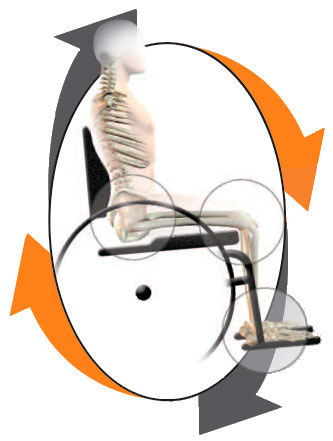
Note: 90° is used as a reference only. All angles should be a direct translation of the body angles found during clinical assessment.
Thigh to Trunk Angle
Seat-to-Back Support Angle
Assessment Goals
During the range of hip flexion, with the spine in its optimal alignment, the assessment identifies the point at which hip range of motion (ROM) is exceeded and pelvis rotates rearward.
Technical Considerations
Consider altering the seat-to-back support angle to accommodate client's hip ROM.
Greater than 90°
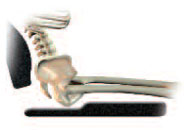
- Pelvis may rotate rearward, trunk becomes kyphotic and hips can slide forward.
- Body mass behind the center of gravity - client has greater probability of sliding.
- Extensor tonal patterns may be triggered.
Less than 90°
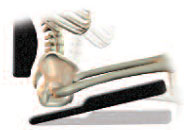
If seat-to-back support angle is less than flexion can tolerate, the pelvis may rotate rearward and client may slide forward or pelvis may anteriorly rotate creating trunk instability.
Thigh to Lower Leg Angle
Seat-to-Lower-Leg Support Angle
Assessment Goals
With the pelvis in its optimal position and thighs loaded, maintain lower leg in best position for loading the foot while respecting hamstring range relative to seating.
Technical Considerations
Seat-to-lower-leg support angle can be altered by the hanger angle, seat depth, footplate placement on the hanger, as well as use of calf strap or pad.
Greater than 90°
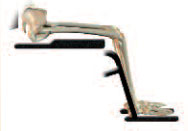
If the thigh-to-lower-leg angle is greater than hamstring range can tolerate with the pelvis in optimal alignment, hamstring tightness may pull pelvis forward, pelvis may rotate rearward and client could slide out of chair. It may be more difficult to properly load feet. Chair is longer which may affect maneuverability.
Less than 90°
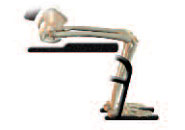
If the seat-to-lower-leg support angle is less than quadriceps range can tolerate - pelvis may be pulled into an anterior tilted position with compensating trunk hyperextension and imbalance.
- More difficult to properly load feet.
- May need higher seat height to avoid caster interference.
Lower Leg to Foot Angle
Foot Support Angle
Assessment Goals
With the pelvis, thighs, and lower leg in optimal alignment, maintain foot in its best position for loading as close to neutral as is possible.
Technical Considerations
Footplate angle.
Greater than 90°
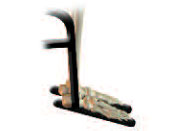
- Consider adjusting the footplate angle to accommodate decreased ROM at the ankle joint.
- May require higher seat height.
- Consider influence on tonal patterns and abnormal reflexes.
Less than 90°
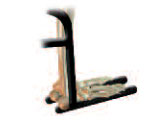
- Consider stretch on achilles tendon.
- Consider foot weight loading and stability.
- May require higher seat height.
- Consider influence on tonal patterns and abnormal reflexes.
Orientation
Assessment Goals
Orientate the client and seating/mobility system in a position relative to gravity, providing optimal functionality and ability to stay upright in the system.
Technical Considerations
Consider mobility base selection.
- Seat frame angle adjustability
- Overall length of frame
- Seat-to-floor height
- Ability to interface with seating
Vertical
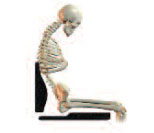
- Client may be unable to hold head/trunk upright against gravity.
- Position may require excessive muscle activity.
- Up to 25 degrees of posterior tilt may offer postural stability.
- 45-55 degrees of posterior tilt required for pressure distribution.
Tilted
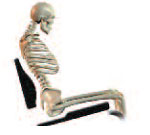
- Client may pull forward - away from the back support.
- Visual orientation may be negatively impacted.
- Consider safe swallow position.
- Consider effect on function.
Clinical Support Information Citations
- Waugh, K. and Crane, B. (2013). A clinical application guide to standardized wheelchair seating measures of the body and seating support surfaces (rev. Ed.). Denver, CO. University of Colorado Denver. Available from: ucdenver.edu/centers/center-for-inclusive-design-and-engineering
- Waugh, K. and Crane, B. (2013). Glossary of wheelchair terms and definitions. Denver, CO. University of Colorado Denver. Available from: ncart.us/uploads/userfiles/files/glossary-of-wheelchair-terms.pdf
- Zwick, D. (2014). How Posture Goes Wrong: Body Shape Distortion in Cerebral Palsy. Available from: omicsonline.org/open-access/how-posture-goes-wrong-body-shape-distortion-in-cerebral-palsy-2157-7595.1000e115.php?aid=25348